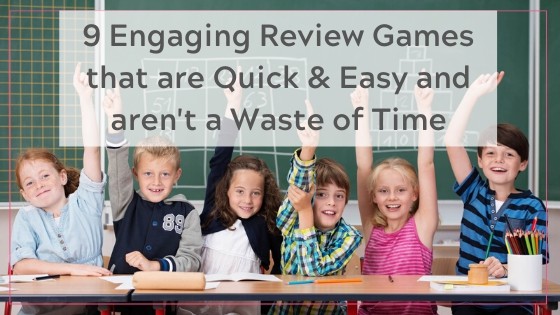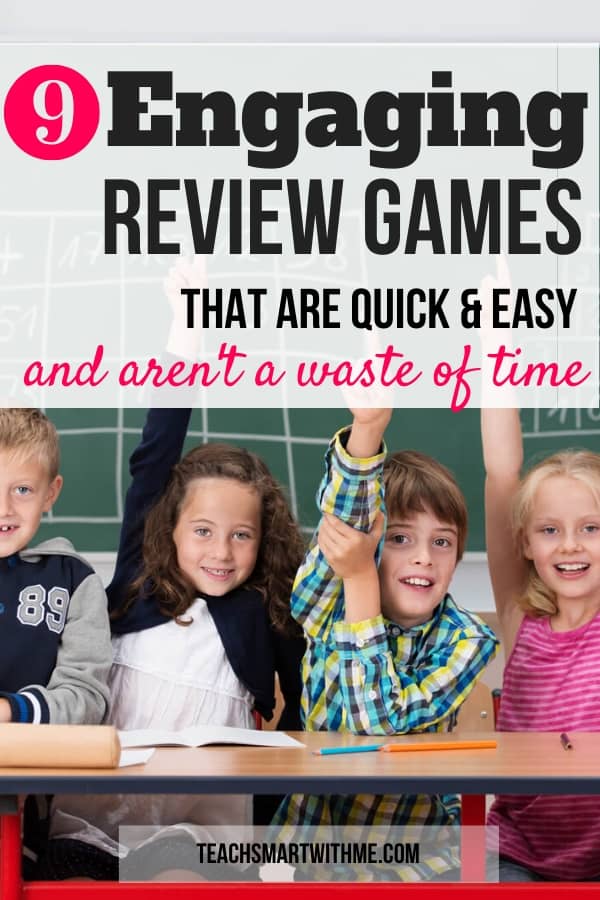Looking for ideas for engaging review games for your class that work? Read to find some quick and easy review games for primary students that won’t waste your time!

Old ideas for revision
Revision or review of learned classroom work can be a pretty boring task for kids.
N.B. In Australia, we call it revision, but if you are used to the word review, I can use these phrases interchangeably.
Yes, you can give them a revision sheet or you could put revision questions on the board.
Both of these types of activities have value. They give you opportunities for monitoring their learning while guiding you on what to reteach before assessment time.
But for kids, these activities all the time are BORING!
New ways of looking at reviewing class work
Why don’t you use some engaging games that are quick and use more of a collaborative approach to help your students review their learning?
From time to time, I try to change up my revision/review activities in my class, especially for my grade 5 students.
This age group has so much stimulus from technology in their every day lives, that we definitely need to make learning more engaging for them.
Have you noticed how competitive they are at this age? This can work well for revision and review games.
I’ve compiled a list of some classroom review games for kids at the middle primary age, that are quick and easy to set up and implement into your revision routine.
I use them regularly and they work a treat!
It will change things up, not waste your time and make revision a bit more fun for your students.
Engaging Review games and ideas
The following revision ideas include some more active review games, including the well-known ‘around the world’, plus other revision activities that I use regularly to revise classroom work.
1. Group contests/table points
Group contests are an engaging way for students to collaborate in their revision of school work. (If you’re clever with the groupings, it will also help students to learn from their peers in the process.)
For these group contests, you will need to explicitly teach your class how the contest will work; plus include information about their discussions while deciding on their responses.
Groups are numbered and each will gets to give their answer. If they get it right, every group will get a point.
A good way to run this is to designate roles in each group. For example, a) a student who records responses, b) ideas people, c) scorekeeper etc.
Group contests work best with no more than 4 or fewer students in a group.
2. Around the World
This is a very classic and well-loved game. Many teachers use ‘Around the World’ for many quick-response types of questions. It works well for number facts, particularly, but it can be used for any other short answer types of questions.
How it works –
- One student stands behind another student. These two, verse each other for a question.
- If each child answers the question correctly at the same time, another question will be asked of them. If the student who’s standing answers the question correctly first, this child moves to the next student and continues around the class.
- If the student sitting down answers the question correctly, before the student standing, they will take the place of the standing student and move to the next.
- The student who got the question wrong sits in the place of their opponent.
- The winning student answers the most questions correctly and moves the farthest around the class -“Around the World.” (The students will help you keep track of the most wins)
3. Personal Whiteboards
I use personal whiteboards for students and their dry erase markers in my room every day.
These small whiteboards are a quick way for students to respond to answers in a written way. Plus helping me, as the teacher, to easily monitor their learning and offer help and suggestions, where needed.
Students can also share their responses with the student next to them and get timely feedback.
Personal whiteboards are an engaging way to revise work instead of having the students write answers into their exercise books. (I think it just a novelty way than pencil and paper, but it works!)
4. Paired challenges
As the name suggests, paired challenges are another way to review content.
When students get to collaborate with a partner, it’s more valuable than just reviewing on their own. This allows them to learn from each other and help them make connections that they might not have previously made.
Tip: By cleverly pairing up students, it enables a strong student to support a weaker student, which benefits them both. Firstly, the stronger student gives explanations to their peer (which gives them a deeper understanding of the content) and secondly, the weaker student may understand his peer’s explanation in a different way. Win-Win!
5. Game Shows
Games Show formats are such a fun way to revise work.
Constructing your game show in a PowerPoint presentation, I must admit is a lot of work, but after it is made, you can continue to use it year after year.
Construct your game show to follow popular shows on television, like ‘Who Wants to Be a Millionaire. This is a great format because you can set up multiple-choice questions and it really gets the student thinking.
They love the fact that they are earning ‘money’ in the game too! which they can track through the game and share their totals at the end.
6. Catch the Fish
I have a very larger, colourful fish puppet that adds a fun element to my revision times with the class. I use it at the beginning of lessons to quickly revise what we have learnt over several lessons to help consolidate knowledge.
I set the scene of what we will be reviewing – for example – What do you know about the Language Features of Narratives? Then I throw the fish to each student as they recall what they remember. This continues around the whole class until each student has a turn.
N.B. The trick is, students can’t answer something that has previously been offered and they can’t talk if they don’t have the fish in their hand.
My kids love this activity and it’s a really fun and engaging way to review past content, get them thinking quickly, as well as have every child answer.
For this game, you can use any type of large soft toy as something to be thrown and caught by the students.
7. Whole class brainstorm activities
I love doing a whole-class brainstorm at the end of a unit of work.
If you record your classes responses to a particular question on a mind-map chart, it’s a clever way to revise many weeks of work and have a visible reminder on the wall to refer back to.
It’s great for subjects like; English, History or Science etc.
Examples of whole-class brainstorm questions:
- What have we learnt about….?
- What are all the elements you need in a narrative story?
- What language features do you need to include in an entertaining narrative?
- What are the qualities of light? etc. etc.
8. Warm-ups
Warm-ups are another quick strategy to recall students knowledge at the beginning of each lesson.
‘Warm-ups’ are activities that call on student’s the prior-knowledge from past lessons. As part of your explicit instruction, a “warm-up’ is essential for students to revise information, skills and concepts they have previously learned.” ‘Warm-ups’ “move knowledge from the student’s short term memory to their long-term memory, as well as build automaticity.”
Just choose a few quick questions or activities from the previous lesson and go over them at the start of a new lesson. This will help build their mastery in the topic.
For many warm-up opportunities, it’s helpful to get students to respond on their personal whiteboards. This gives them a chance for a quick response as a whole class, share with a friend and also get some immediate feedback on their work. You can also use peer tutors to go and quickly help those that need it, on the spot.
I love warm-up activities, as they are a quick way to review work and help students to gain confidence and achieve success in areas needing it.
By using this activity on a daily basis, you’ll see a huge improvement in student achievement and the kids will love it.
9. Buzz
The game of ‘Buzz’ is another fun way for revision. It a very engaging for the whole class and I often use it to revise spelling words for the week or for a whole term review.
How it works –
All of your class form a large circle around the outer part of the room. They don’t need to stand in any particular order, but you will need to give them clear expectations of the positive behaviours needed to play the game in a safe and respectful manner.
- Start the game by picking a student.
- Then the teacher chooses a word that the class will spell, for example, ‘Respectful’ – the beginning student says the first letter of the word – ‘R’, then the next student says the next letter -‘E’ and so forth.
- If a student says the wrong letter, they sit down and are out of that round.
- Once all the letters for the word are spelt, the next person must say the word ‘Buzz!’ If they forget, they sit down, if they remember the next person sits down.
- Then you start on subsequent spelling words until all the students are out.
- The last person standing is the winner and they begin the new game.
It’s a great way to develop listening skills as well as revising work.
In closing:
I hope these suggestions have given you some ideas for your next revision session.
I know my classes of grade 5’s have really loved these engaging revision game over the years and are certainly not bored.
I hope your kids love them too!
PIN THIS FOR LATER!

Michelle x


Leave a Reply